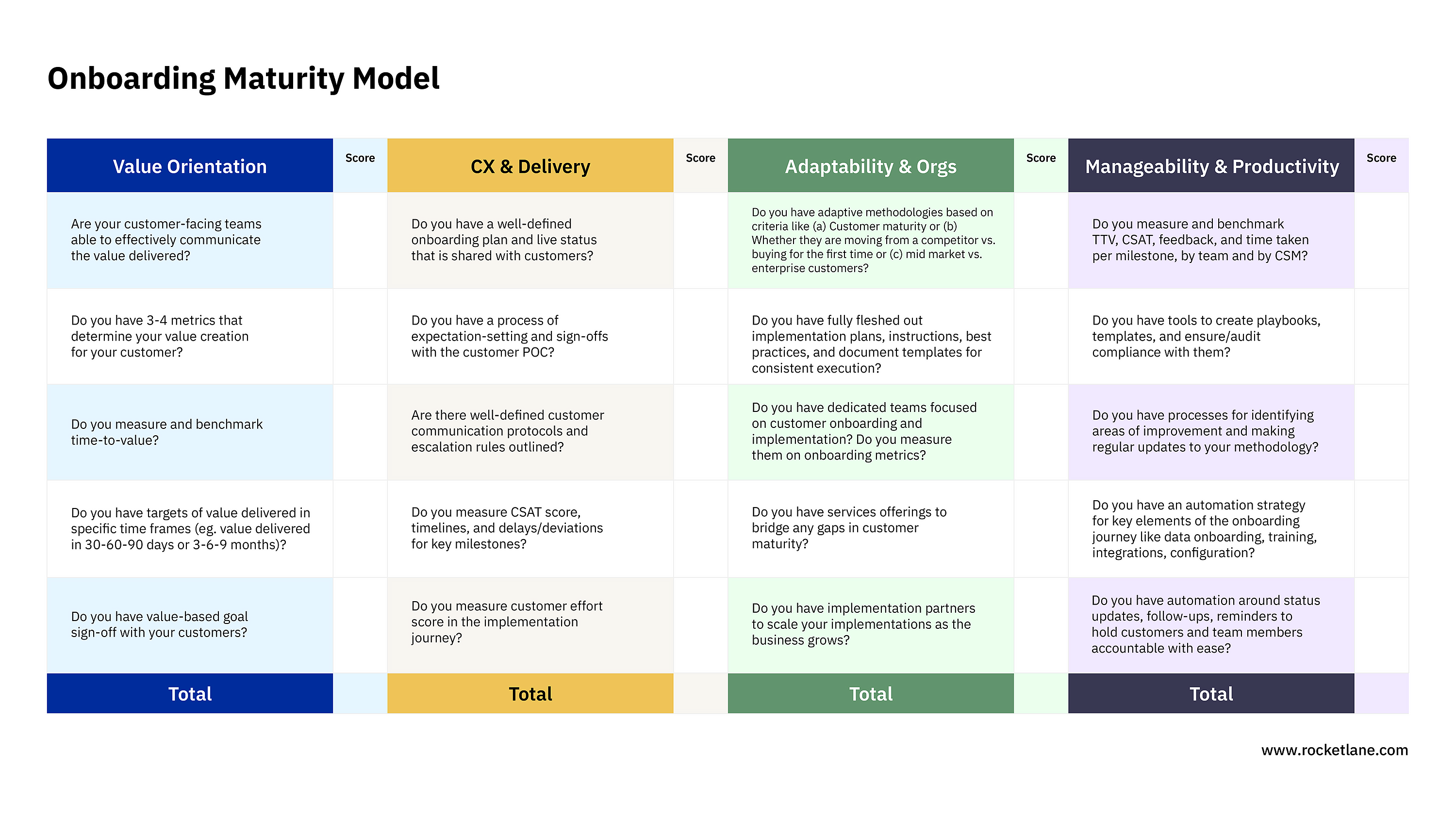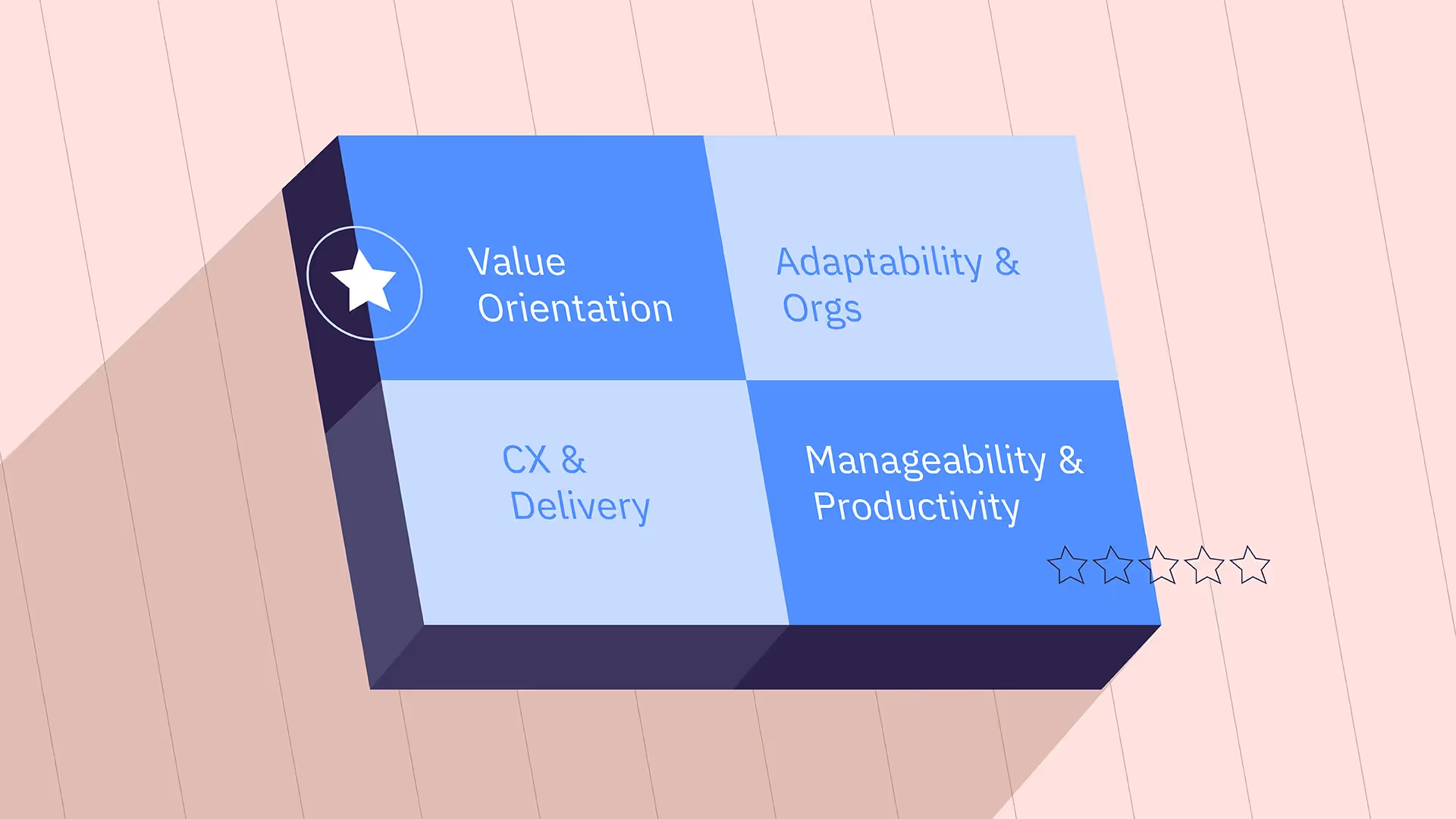A customer onboarding project can feel a lot like a game of Jenga with multiple players, where if one person makes the wrong move everything can fall apart.
You have to make sure you don’t topple the entire plan when working on a specific activity. You’re constantly worrying about how best to make it smooth for your customer. Or your optimization efforts are giving lesser and lesser returns with every project.
So how do you get better at the customer onboarding game and increase your chances of desirable outcomes? Well, we have a maturity model that can help you with just that.
A maturity model helps you understand the areas in your customer onboarding methodology that require improvement. It also enables you to prioritize specific areas that you want to improve based on your company’s maturity level.
Based on our own experience having worked in the onboarding space and our conversations with peers in the customer onboarding and implementation area, we’re launching today our Customer Onboarding Maturity Model:

Before we get into the details, some points to note:
- This model is for medium to high touch customer onboarding projects that involve at least a three-week project duration to deliver value. You can borrow our ideas on the dimensions and create your own model if you want to adapt the it for simpler/self-serve SMB onboarding.
- To keep things simple, we've started with restricting the model to four dimensions. To get to four, we had to combine some dimensions which may eventually deserve their own dedicated space in the future.
- We haven't added core Professional Services elements like utilization rate, project profitability, etc. at this time as we focused on a model for CS teams that also handle customer onboarding. We may create a version for professional services - collaborators welcome! Write to us at care@rocketlane.com or reach us on the Preflight community.
- Keep in mind the context and maturity of your company as you look at the model. Your customer onboarding maturity should be in line with your company's growth. So a low score on a dimension isn't always bad - it might be right for your stage.
Dimension 1: Value Orientation
This dimension helps you understand how value-focused you are as a company. For SaaS businesses, it is essential that the customer gets to value realization faster. The more customers who can see value quickly, the lesser the frustrations and churn and for your business. Ultimately, delivering value is the most important thing to do to increase your NRR.
Are teams able to articulate value?
For this indicator, analyze whether everyone on your team understands what value you are trying to unlock for the customer. This gives you a fair idea of how value-oriented your CS org is and where you need to intervene and help people reorient.
Do you measure ROI/value?
Are you able to measure the ROI and value? Are the metrics you are looking at aligning with the ROI you are measuring when delivering value to your customer? To measure your ROI, you need to conduct pre-implementation and post-implementation measurements in the customer org to showcase the value you will deliver. E.g., if you are implementing your chatbot for a customer who has switched from a competitor, you need to showcase how your product is doing better than the competitor’s. You need to spend some effort in benchmarking before showcasing your ROI, as the latter will depend on the former. Without that benchmarking, showcasing to your customer what value you have added will be difficult and hypothetical.
Are you measuring and benchmarking TTV?
Time-to-value is an important metric, mainly for SaaS businesses. Any delay in your customer realizing value can increase the chances for churn.
Are you tracking 30-60-90 day ROI?
This is another way to orient yourself around the ROI of your onboarding. You could use 30-day, 60-day, 90-day milestones and track the value delivered for each of these durations.
Does your process include value-based goal sign-off with the customers?
Instead of focusing on features and modules to be implemented, focus on the value you will deliver and align with your customers on the value to be delivered. Your scope will also be oriented towards this. If you apply this to the chatbot implementation scenario discussed earlier, the goal would look like the percentage of effort the chatbot could save in monetary terms instead of the types of questions the chatbot could handle on its own.
Dimension 2: CX & Delivery
The second dimension focuses on the onboarding experience for your customer and how you deliver their onboarding goals.
Customer onboarding plan and live status
Check whether you have a robust onboarding plan and live status that can be showcased to the customer at every stage in the journey. Knowing you have a solid plan and that they can access the project status at any time during the onboarding journey will win the customer’s confidence.
Expectation setting and sign-off
Setting the right expectations with your customer and getting crucial sign-offs from them to ensure that teams are aligned and don’t get surprised should be a part of your customer onboarding process. You also need to have communication protocols defined to ensure that stakeholders know when to escalate and whom to escalate to; this way, everyone will know exactly what to do when faced with issues. This is an indicator of how mature your customer onboarding process is. The more mature your strategy, the smoother the experience is for the customer.
Measure CSAT score, timelines, and delays
How often your customer onboarding projects are delayed, what goals take longer than estimated to reach, and the CSAT scores indicate where your onboarding process needs improvement.
Customer effort score
Does the onboarding process wear your customer down? Does it seem like it is asking a lot from them? How much heavy lifting do they have to do? The Customer Effort Score (CES) measures these aspects and will help you know where you need to make things easier for your customers in the onboarding journey.
You might want to read: PartnerStack’s Data-Driven Customer Onboarding Decisions
Dimension 3: Adaptability & Organization
This dimension evaluates how well your onboarding methodology adapts to the needs of your customers and how your company is equipped to handle customer onboarding.
Adaptive methodologies
Do you change your onboarding process and plans according to the maturity of your customer or their industry? This influences your strategy, your customer onboarding goals, and the people from your org who will engage. E.g., Suppose a customer has never used a product like yours before. In that case, that will need specific team members of yours who are good at implementing the product for such customers, and the goals would also be different from that of a customer who is switching from a competitor.
See also: Decoding Customer Onboarding at Insent: Classifying customers
Implementation plans and doc templates
Are you able to achieve consistency through your systems and processes? E.g. by having templates for your projects and onboarding documents, you can achieve consistency and a higher rate of adherence to the process.
A dedicated customer onboarding team
Do you have a team dedicated to onboarding customers? Or does the same team involved in all post-sales activities handle customer onboarding too?
Services offerings based on customer maturity
Not all customers are equal. Some of them may need you to fill specific gaps for them before you begin onboarding them. Otherwise, they don’t fall under your ICP anymore.
Implementation partners
As you grow and expand, you may want to start looking at external partners to start implementing on your behalf instead of just adding more people to your implementation team.
Dimension 4: Manageability & Productivity
This dimension assesses your process to track customer onboarding metrics and your project management strategies and plans.
Metrics by milestones, team, region
Are you able to capture metrics? Are you able to look at TTV, CSAT, time taken per milestone, and slice your data based on region, team, etc.? This would give you a clear picture of what the best effort looks like and help you create a benchmark internally for your customer onboarding function.
Audit compliance to playbooks
Do you have ways to audit compliance with your playbooks and the timelines and processes around them? Are you able to check if your team is adhering to best practices?
Continuous improvement/iteration on methodology
Is there a process in place to measure success regularly, say every quarter or so? Is there a conscious effort or program geared towards improving your customer onboarding methodology?
Automation strategy
There are many areas in your customer onboarding journey where you can automate activities that are being done manually, such as enabling certain features and configurations. Automating them impacts CES and helps you scale faster.
See also: How Crew moved from high-touch to self-serve for their SMB customer onboarding
Project management automation
Can activities that are being done manually, such as follow-ups and status updates, be automated? This frees up time for the customer onboarding manager, and they can focus on process improvements.
Read more: Top 5 benefits to having a dedicated platform for customer onboarding
What is your Customer Onboarding Maturity Score?
There is no universal ideal or ‘right’ score for your customer onboarding process. If you score low on a dimension, it is simply a cue for you to reflect upon whether that works for your company or if it is something to focus on. If you have multiple areas with low scores and are looking to improve them, you could take one theme, say, every quarter and work towards improving it.
What is your customer onboarding maturity score? Click here to find out















